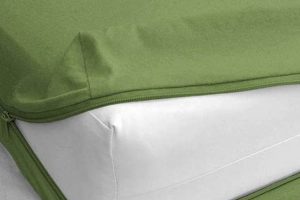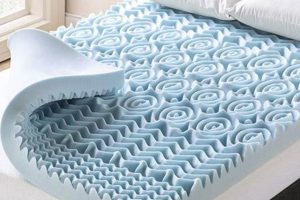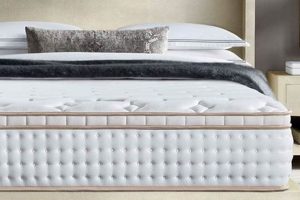A cushioning layer, typically made of natural or synthetic rubber derived from the sap of rubber trees, is designed to be placed on top of an existing mattress to modify its feel. With a thickness of four inches, this particular product offers substantial contouring and pressure relief, potentially alleviating discomfort associated with firm or aging mattresses. As an example, an individual experiencing hip pain might use this product to soften the sleeping surface and reduce pressure points.
The advantage of utilizing this type of bedding addition lies in its ability to enhance comfort, improve spinal alignment, and extend the lifespan of the underlying mattress. Historically, similar bedding modifications have been employed to address uneven mattress surfaces or provide an added layer of insulation against the cold. Furthermore, the materials inherent breathability and resilience contribute to a cooler and more supportive sleep environment.
The subsequent sections will delve into the various types of materials used in these additions, the factors influencing their suitability for different sleep styles, and practical considerations for selecting and maintaining this bedding accessory. This will provide a detailed understanding of its applications and benefits.
Tips Regarding Four-Inch Latex Mattress Enhancements
The following guidance aims to inform prospective purchasers and current users about optimizing the selection, use, and maintenance of four-inch latex mattress additions for improved sleep quality and longevity.
Tip 1: Assess Underlying Mattress Condition. Before acquiring a four-inch latex layer, evaluate the condition of the existing mattress. If the underlying mattress is severely sagging or damaged, the addition may only provide limited improvement and replacement of the entire mattress should be considered.
Tip 2: Consider Density and ILD Rating. Latex is available in varying densities, indicated by its Indentation Load Deflection (ILD) rating. A lower ILD provides a softer feel, while a higher ILD offers firmer support. Select a density appropriate for individual sleep preferences and body weight.
Tip 3: Prioritize Natural Latex Options. While synthetic latex options exist, natural latex, derived from rubber trees, typically offers superior durability, breathability, and resistance to dust mites and mold. Certifications such as Oeko-Tex or GOLS can verify the purity and environmental sustainability of natural latex.
Tip 4: Implement a Protective Cover. To safeguard the latex from spills, stains, and general wear, utilize a mattress protector designed specifically for latex. This can prolong the life of the mattress layer and maintain its hygienic properties.
Tip 5: Rotate Regularly. To ensure even wear and prevent body impressions, rotate the four-inch latex addition 180 degrees every few months. This practice contributes to a more consistent sleeping surface over time.
Tip 6: Clean Spills Immediately. Should a spill occur, address it promptly with a clean, absorbent cloth. Avoid harsh chemicals or abrasive cleaners, as they can damage the latex. Spot cleaning is generally preferable to saturation.
Tip 7: Maintain Adequate Ventilation. Ensure proper ventilation around the mattress and latex addition to prevent moisture buildup. Avoid placing heavy objects directly on the surface for extended periods, as this can compress the material.
Adhering to these recommendations can maximize the comfort, support, and longevity of a four-inch latex mattress enhancement, ultimately leading to improved sleep quality and overall well-being.
The subsequent sections will discuss integrating the addition with various bed frames and foundations to ensure proper support and stability.
1. Firmness and ILD Rating
The correlation between firmness and Indentation Load Deflection (ILD) rating is pivotal in assessing the suitability of a four-inch latex addition for individual needs. The ILD rating, measured in pounds, quantifies the force required to compress a specified area of the latex material by a defined percentage. A lower ILD value signifies a softer feel, allowing for greater contouring and pressure relief. Conversely, a higher ILD value indicates a firmer surface, providing increased support and resistance to compression. For instance, an individual with a higher body weight may benefit from a latex layer with a higher ILD to prevent excessive sinking and maintain proper spinal alignment, while a lighter individual may prefer a lower ILD for enhanced comfort.
The selection of an appropriate firmness and ILD rating directly affects the user’s sleep experience. A four-inch latex addition that is too soft may lead to inadequate support and potential back pain. Conversely, a layer that is too firm may create pressure points and discomfort. Therefore, understanding the relationship between these parameters is crucial for optimizing sleep quality. Real-world scenarios highlight the importance of this understanding. Side sleepers, for example, often require a lower ILD rating to cushion the shoulders and hips, while stomach sleepers typically need a firmer surface to prevent lower back strain. The practical significance lies in preventing or mitigating sleep-related discomfort and promoting restorative rest.
In summary, the firmness and ILD rating of a four-inch latex addition are inextricably linked to its performance and suitability for individual sleep preferences. A thorough understanding of this connection enables informed decision-making, allowing consumers to select a product that effectively addresses their specific needs and contributes to improved sleep quality. Challenges arise from subjective preferences and variations in body weight and sleeping position, necessitating careful consideration and potentially, in-person testing, before finalizing a purchase. This directly impacts the product’s efficacy and ultimately, the user’s satisfaction.
2. Natural vs. Synthetic
The distinction between natural and synthetic latex is a crucial determinant of the performance and characteristics of a four-inch latex addition. Natural latex, derived from the sap of rubber trees (Hevea brasiliensis), possesses inherent properties contributing to durability, breathability, and resilience. Synthetic latex, typically produced from petrochemicals, often exhibits inferior performance in these areas. The selection of one material over the other directly impacts the longevity, comfort, and potential health implications associated with the product. For instance, a four-inch addition composed of natural latex is more likely to resist compression over time and provide superior airflow, mitigating heat retention and promoting a cooler sleep environment. Conversely, a synthetic latex addition may degrade more rapidly and exhibit limited breathability, potentially leading to discomfort and reduced lifespan.
The implications of choosing between natural and synthetic latex extend beyond mere comfort and durability. Natural latex is generally considered to be hypoallergenic and resistant to dust mites and mold, rendering it a suitable option for individuals with allergies or sensitivities. Synthetic latex, depending on its composition, may contain volatile organic compounds (VOCs) that can off-gas and potentially irritate sensitive individuals. Practical applications of this understanding are evident in healthcare settings, where natural latex is frequently preferred for its hygienic properties and reduced risk of allergic reactions. Moreover, the environmental impact of production differs significantly. Natural latex production is a renewable process, while synthetic latex relies on non-renewable resources and can generate more significant environmental pollution.
In conclusion, the choice between natural and synthetic latex in a four-inch addition is a decision with multifaceted consequences. While synthetic options may offer a lower initial cost, natural latex generally provides superior long-term value due to its enhanced durability, breathability, and hypoallergenic properties. Challenges arise in accurately identifying the composition of latex products, as some manufacturers may blend natural and synthetic materials without clear labeling. Therefore, consumers should prioritize products with certifications from reputable organizations, such as Oeko-Tex or GOLS, to ensure authenticity and minimize potential health and environmental risks. This ultimately contributes to a more informed purchasing decision and a higher likelihood of achieving optimal sleep quality and long-term satisfaction.
3. Thickness and Support
The thickness of a latex mattress addition is intrinsically linked to the level of support it provides. A four-inch thickness represents a substantial layer designed to significantly alter the feel and support characteristics of an existing mattress. The degree of support directly impacts spinal alignment, pressure relief, and overall sleep comfort. The following facets detail the relationship between thickness and support.
- Contouring and Pressure Relief
The four-inch thickness allows the latex to conform to the body’s curves, distributing weight more evenly and reducing pressure points. For example, side sleepers may experience relief in the shoulder and hip areas due to this contouring. Insufficient thickness would limit this effect, resulting in increased pressure and potential discomfort.
- Spinal Alignment
Proper spinal alignment is crucial for preventing back pain and promoting restful sleep. A four-inch layer can help maintain natural spinal curvature, particularly for individuals whose existing mattress lacks adequate support. Without sufficient thickness, the body may sink into the mattress, causing misalignment and strain.
- Motion Isolation
The thickness of the latex contributes to motion isolation, reducing the transfer of movement between sleeping partners. A four-inch layer absorbs and dampens movement, minimizing disturbances. Thinner layers offer less motion isolation, potentially leading to disrupted sleep.
- Edge Support
While the core function of a mattress addition is to modify the sleep surface, a four-inch thickness can also provide some level of edge support, preventing the feeling of rolling off the bed. Thinner layers offer minimal edge support, which can be a concern for individuals who sleep near the edge of the bed.
These facets illustrate that the four-inch thickness of a latex addition is not merely a superficial dimension; it directly influences the support characteristics and overall sleeping experience. The combination of contouring, spinal alignment, motion isolation, and edge support provided by this thickness contributes significantly to its ability to enhance comfort and promote restful sleep. A thinner addition would compromise these benefits, while a thicker addition might introduce unwanted changes in mattress height and feel.
4. Durability and Longevity
Durability and longevity are critical considerations when evaluating a four-inch latex mattress addition. These attributes dictate the product’s lifespan, its ability to maintain performance characteristics over time, and its overall value proposition. Several factors influence the durability and longevity of such additions.
- Material Composition
The type of latex utilizednatural, synthetic, or a blendsignificantly impacts durability. Natural latex generally exhibits greater resilience and resistance to degradation compared to synthetic alternatives. For instance, a four-inch addition made of 100% natural Dunlop latex is expected to retain its shape and supportiveness longer than one made of synthetic latex. Impurities and fillers in lower-quality latex can accelerate breakdown.
- Density and ILD Rating
Higher-density latex, characterized by a higher Indentation Load Deflection (ILD) rating for a given firmness, typically demonstrates improved durability. Denser materials are more resistant to compression and deformation over time. A four-inch addition with a high-density core will be less prone to sagging or developing body impressions, thereby extending its lifespan. This applies to both natural and synthetic variants.
- Manufacturing Process
The manufacturing process influences the structural integrity and longevity of the latex. Vulcanization, a process that enhances the strength and elasticity of latex, must be performed correctly to ensure optimal durability. Improper vulcanization can result in a product that is more susceptible to tearing or crumbling. The method used, such as Dunlop or Talalay, can also affect the material’s long-term performance.
- Usage and Maintenance
Proper usage and maintenance practices are crucial for maximizing the lifespan of a four-inch latex addition. Regularly rotating the addition can help distribute wear evenly and prevent the formation of body impressions. Protecting the latex from direct sunlight, moisture, and harsh chemicals is also essential. Neglecting these precautions can accelerate the deterioration of the material and shorten its lifespan.
In conclusion, the durability and longevity of a four-inch latex addition are determined by a complex interplay of material composition, density, manufacturing processes, and user care. Opting for high-quality natural latex, prioritizing density, and adhering to recommended maintenance practices can significantly extend the lifespan of the product and ensure long-term comfort and support. Understanding these factors enables informed decision-making and maximizes the investment in enhanced sleep quality.
5. Breathability and Cooling
The breathability and cooling properties of a four-inch latex mattress addition significantly influence sleep comfort, particularly in warm climates or for individuals prone to night sweats. The material’s inherent structure and composition play a pivotal role in regulating heat dissipation and moisture management.
- Open-Cell Structure
Latex, especially natural latex, possesses an open-cell structure characterized by interconnected air pockets. This structure facilitates airflow through the material, allowing heat to dissipate more effectively than closed-cell foams like memory foam. As an example, the open-cell design of a four-inch latex addition enables convective heat transfer away from the body, preventing the buildup of heat that can lead to discomfort and disrupted sleep.
- Natural Latex Superiority
While both natural and synthetic latex exhibit some degree of breathability, natural latex generally outperforms synthetic alternatives due to its less dense and more porous structure. The manufacturing process can also influence breathability; Dunlop latex tends to be denser than Talalay latex, potentially affecting airflow. For instance, a four-inch Talalay latex addition is often preferred for individuals seeking maximum cooling benefits due to its enhanced breathability.
- Moisture Wicking
Breathability is closely linked to moisture wicking, the ability of a material to draw moisture away from the body. Latex’s porous structure allows it to absorb and evaporate moisture, helping to regulate body temperature and prevent the feeling of dampness. A four-inch addition with good moisture-wicking properties can contribute to a drier and more comfortable sleep environment, reducing the likelihood of night sweats.
- Cover Material Impact
The cover material surrounding the latex addition can significantly impact its breathability and cooling effectiveness. A cover made of natural fibers, such as cotton or bamboo, allows for greater airflow than synthetic materials like polyester. A four-inch latex addition encased in a breathable cotton cover will provide better cooling performance compared to one with a synthetic cover, even if both additions are made of the same type of latex.
Collectively, these facets highlight the importance of considering breathability and cooling properties when selecting a four-inch latex mattress addition. The combination of open-cell structure, natural latex composition, moisture-wicking capabilities, and breathable cover material contributes to a cooler and more comfortable sleep experience, mitigating the effects of heat retention and promoting restful sleep. A strategic approach to integrating these characteristics ensures an optimized sleep environment.
Frequently Asked Questions
The following addresses common inquiries regarding the selection, usage, and maintenance of a four-inch latex mattress addition. The information presented is intended to provide clarity and facilitate informed decision-making.
Question 1: What is the expected lifespan of a four-inch latex mattress addition?
The lifespan is contingent upon material composition, density, and usage patterns. A high-quality natural latex addition, properly maintained, can last from 7 to 10 years. Synthetic latex additions typically exhibit a shorter lifespan, ranging from 3 to 5 years.
Question 2: How does a four-inch latex mattress addition impact the feel of an existing mattress?
A four-inch latex addition significantly alters the feel of the underlying mattress. It provides increased contouring, pressure relief, and overall cushioning. The specific impact depends on the firmness of the latex, with softer options providing a plusher feel and firmer options offering more support.
Question 3: Are all four-inch latex mattress additions suitable for individuals with allergies?
Natural latex is generally hypoallergenic and resistant to dust mites. However, individuals with a known latex allergy should exercise caution and consult with a healthcare professional before using a natural latex addition. Synthetic latex additions may contain allergenic compounds and should be carefully evaluated.
Question 4: How should a four-inch latex mattress addition be cleaned?
Spot cleaning with a mild detergent and water is recommended. Harsh chemicals and abrasive cleaners should be avoided, as they can damage the latex. The addition should be thoroughly dried after cleaning to prevent mold growth.
Question 5: Will a four-inch latex mattress addition fit on all bed frames?
The addition’s dimensions are standard, but it is imperative to verify compatibility with the existing bed frame. The added height may necessitate adjustments to headboards or footboards. Incompatibility can compromise support and stability.
Question 6: What is the difference between Dunlop and Talalay latex?
Dunlop latex is denser and firmer due to its manufacturing process. Talalay latex is lighter and more breathable. Dunlop latex is typically more durable, while Talalay latex offers superior comfort and pressure relief.
In summary, a four-inch latex mattress addition offers numerous benefits, but careful consideration of material composition, firmness, and maintenance is essential to maximize its lifespan and ensure optimal sleep quality.
The next section will explore specific scenarios for integrating the addition into existing sleep systems.
Conclusion
This exploration has provided a comprehensive overview of the characteristics, benefits, and considerations associated with a 4 inch latex mattress topper. Key aspects examined include material composition (natural vs. synthetic), firmness and ILD rating, thickness and support, durability and longevity, and breathability and cooling properties. These factors collectively influence the product’s suitability for individual sleep needs and its long-term performance.
The decision to integrate a 4 inch latex mattress topper into a sleep system warrants careful evaluation of existing mattress condition, personal preferences, and potential benefits. While it can enhance comfort, improve spinal alignment, and extend the lifespan of an underlying mattress, its effectiveness is contingent upon informed selection and proper maintenance. This investment can significantly improve sleep quality and contribute to overall well-being with appropriate consideration.




![Buy Best 8 Inch Tri Fold Queen Mattress [Deals] Organic & Natural Mattress Buyer’s Guide: Non-Toxic Sleep Solutions Buy Best 8 Inch Tri Fold Queen Mattress [Deals] | Organic & Natural Mattress Buyer’s Guide: Non-Toxic Sleep Solutions](https://mattressworldpa.com/wp-content/uploads/2025/07/th-3717-300x200.jpg)
![Best 8 Inch Foam Mattress For [Sleep Style] & Budget! Organic & Natural Mattress Buyer’s Guide: Non-Toxic Sleep Solutions Best 8 Inch Foam Mattress For [Sleep Style] & Budget! | Organic & Natural Mattress Buyer’s Guide: Non-Toxic Sleep Solutions](https://mattressworldpa.com/wp-content/uploads/2025/07/th-3716-300x200.jpg)

